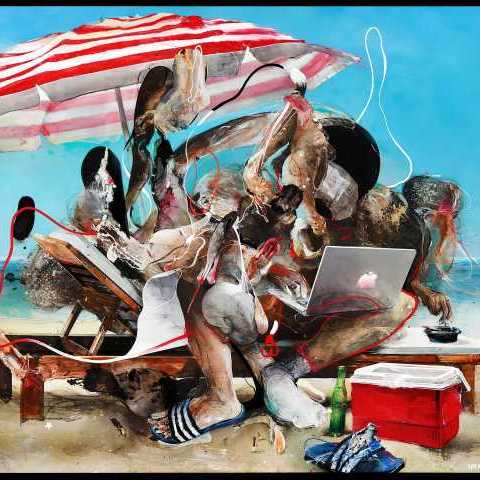JD Malat Gallery
30 Davies Street
Mayfair
London
W1K 4NB
United Kingdom

JD Malat Gallery is delighted to present Contemporary Figuration: Between Body & Metaphor, a group show featuring Georgia Dymock, Emily Gillbanks, Andrew Litten, Ayanfe Olarinde, Yann Leto, Celine Ali, Cathy Tabbakh, Richard Wathen, Han Ji Min, Sophie-Yen Bretez, Natalia Ocerin, and Ur Kasin. The exhibition runs from 14 December, 2023 to 27 January, 2024.
The body is a physical and material being. However, it can also reflect a person’s spirit, sense of ‘self’ or embrace metaphors of our contemporary age. This exhibition seeks to bring together the work of contemporary painters who explore the body as material, and as the embodiment of the immaterial, engaging in themes ranging from the notion of ‘self’, identity, critical race, queer theory and the technological body. It also seeks to shed light on the varying ways in which different artistic styles of figuration can engage with the question of how to picture the human subject today?
In an age where questions of embodied experience are continually accentuated by our relationship with cross-cultural exchange, media, new technologies, and socio-political change, the body has come to signify the transcendental. Different painterly styles that range from realism to abstraction, and technologically informed practices, seek to demonstrate the expansive breadth of contemporary figurative painting and its capacity to tell the stories of diverse bodies and their connotations – the polarised, the ‘ideal’, the natural, the technological, the liminal, and more – and help situate them within the nuanced frameworks of posthumanism, Otherness and diasporic memory.
To encourage an open-minded and all-embracing experience of the exhibition, the curatorial premise is guided by each artist’s personal response to ‘Body & Metaphor’. Both represented artists from the gallery’s roster, and guest artists, are invited to share their thoughts in the catalogue that accompanies the exhibition to champion an artist-centric model of the gallery space and highlight the gallery as platform, rather than mediator.
